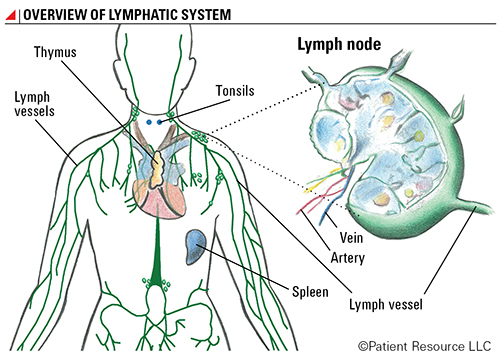Follicular Lymphoma
Overview
When people hear the word cancer, they tend to first think of solid tumors that sometimes spread to other places in the body. But cancers are actually categorized into two main groups: solid cancers and hematologic (blood) cancers. Blood cancers may or may not create an actual tumor and can affect blood, bone marrow, lymph nodes and other organs.
One type of blood cancer is called lymphoma. It arises in the lymphatic system, which is part of the immune system.
Lymphoma develops when normal lymphocytes (a type of white blood cell) transform into abnormal cancer cells that reproduce uncontrollably. As these cancer cells multiply, they collect in the lymph nodes, bone marrow, spleen, tonsils, adenoids or thymus, where they can form tumors. These cells eventually begin to outnumber normal cells, causing an enlargement of the lymph nodes, spleen or other organs.

About the Lymphatic System
To fully understand lymphoma, it’s important to first gain an understanding of the lymphatic system. The lymphatic system is a network of tissues and vessels that carry fluid, called lymph, throughout the body. Lymph contains lymphocytes that attack infectious agents.
The two main types of lymphocytes that can develop into lymphomas are B-lymphocytes (B-cells) and T-lymphocytes (T-cells):
- B-cells produce protein antibodies that attach to infectious organisms, such as bacteria and viruses, marking them for destruction.
- T-cells attack infectious organisms directly and play a part in controlling the immune system.
Both B-cells and T-cells can transform into lymphoma cells. However, in the United States, B-cell lymphomas are much more common.
Types of Lymphoma
Lymphoma represents more than 60 different cancer subtypes that involve lymphocytes, and it can occur in adults and children of any age. The two main types of lymphoma are Hodgkin lymphoma and non-Hodgkin lymphoma.
Hodgkin Lymphoma
Hodgkin lymphoma is characterized by the presence of B-cells (called Reed-Sternberg [R-S] cells), although other cell types also may be present. Hodgkin lymphoma usually starts in the lymph nodes and often spreads from one lymph node to another. It also can spread to other organs.
Non-Hodgkin Lymphoma
Non-Hodgkin lymphoma (NHL) is the most common cancer of the lymphatic system.
NHL is not a single disease but rather a group of several closely-related cancers. The World Health Organization estimates that there are more than 60 types of NHL. Although the various types of NHL share some common features, they differ in their microscopic appearance, molecular features, growth patterns, impact on the body and treatment options.
NHLs are broadly divided into two major groups: B-cell lymphomas and T-cell lymphomas. B-cell lymphomas develop from abnormal B-lymphocytes and account for 85 percent of all NHLs; T-cell lymphomas develop from abnormal T-lymphocytes and account for the remaining 15 percent of all NHLs. NHLs may also be classified as indolent (slow-growing) or aggressive (fast-growing).
Follicular Lymphoma
Follicular lymphoma is the most common form of low-grade NHL and the second most common type of lymphoma overall diagnosed in the United States. Most follicular lymphoma diagnoses occur in adults over the age of 60, with equal rates of occurrence in male and female individuals; this specific lymphoma is rare in young people.
Follicular lymphoma affects B-cell lymphocytes and is indolent, which means it grows very slowly. Like most lymphomas, follicular lymphoma usually begins in the lymph nodes. The cells can spread into the blood and bone marrow. Other internal organs, including the liver and spleen, may also be affected.
Because follicular lymphoma grows so slowly, doctors may not treat it right away and instead adopt a “watchful waiting” approach. Over time, some follicular lymphomas transform into an aggressive (fast-growing) diffuse B-cell type of lymphoma, so it’s important for people with follicular lymphoma to be monitored closely. Learn more about the several treatment options that are available here.



